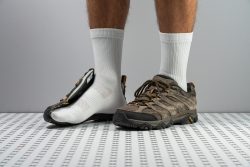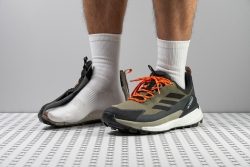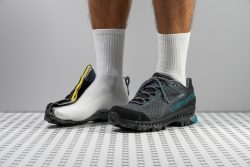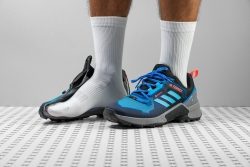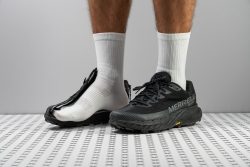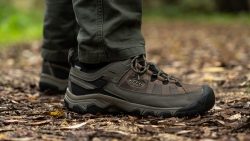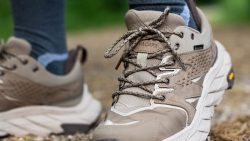6 Best Gore-Tex Hiking Shoes in 2025
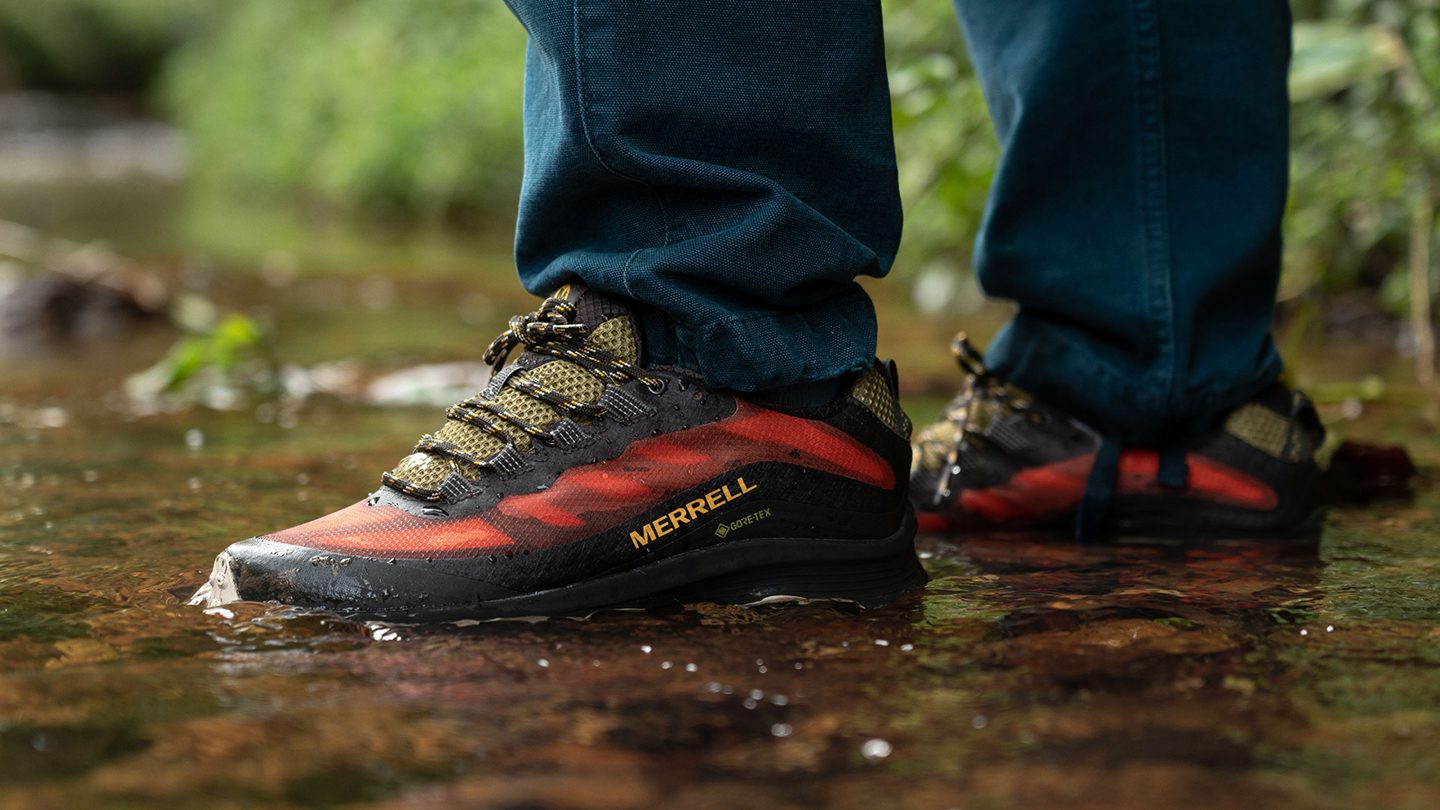
We buy shoes ourselves. We earn commissions when you buy through us, at no extra cost. Why trust us
Get ready for wet weather with Gore-Tex hiking shoes. When your next adventures take you to snowy trails, rainforests, and shallow streams, a pair of hiking shoes with a Gore-Tex membrane can be your most reliable companion, keeping your feet dry and comfortable every step of the way.
Given their popularity, finding the ideal pair can be time-consuming. To help you with that, we have put these hiking shoes through a lot, from our test hikes and stream crossings to lab tests. We evaluated each pair until we ended up with the most noteworthy pairs. We also went down the rabbit hole explaining the pros and cons of GTX hiking shoes in our guide.
How we test Gore-Tex hiking shoes
For this special selection, we hiked to field-test all the Gore-Tex hiking shoes in our inventory. We covered each pair across wet trails and muddy routes. Our selection process includes:
- Buying GTX hiking shoes with our money. This ensures our independence.
- Getting a first-hand assessment of each specific model’s fit, waterproof properties, grip, comfort, protection, and durability, among others.
- Getting more data from the tests we perform in our independent lab. We use calipers, durometers, a liquid gel, a smoke machine, a Dremel, a band saw, and other tools to deliver 20+ data points that accurately describe GTX hiking shoes' features.
Best Gore-Tex hiking shoes overall


































What makes it the best?
After comprehensive lab tests and putting a number of Gore-Tex hiking shoes through their paces, we declare that the Merrell Moab 3 GTX is the best overall! It’s delightfully comfortable straight out of the box and keeps our feet completely dry on our wet hikes.
The thick, padded tongue, measuring 14.6 mm (4.4 mm thicker than average), and the extra padding around the heel area make an excellent first impression from the get-go.
Our feet flex naturally while walking in these shoes. In our bend test, it emerged 16.9% more malleable than average! In practice, this shoe gives a really comfortable ride and a natural feel to our strides.
The Gore-Tex lining is perfectly implemented, and our feet stayed bone dry, even on our rainy hikes with stream crossings. The 4.8 mm lugs are 0.8 mm deeper than average and grip well on gravel and smooth rock. With Vibram rubber in the outsole, it’s a great choice for wet-weather hiking.
Such a workhorse of a shoe has to show some sort of weakness. The indestructible Merrell Moab 3 GTX is on the heavy side, weighing in at 15.9 oz (450g). We don’t recommend it to hikers looking for something fast and lightweight.
Pros
- Superb day-one comfort
- Brilliant surface adhesion
- Supportive like a work shoe
- Remarkably durable
- A-grade waterproofing
- Sheds mud quite well
- Protective toe box
- Incredible overall quality
Cons
- Heavy for a low-top
- Subpar breathability
- Its shoelaces unravel often
- Minimal shock absorption
Gore-Tex hiking shoe with the best shock absorption
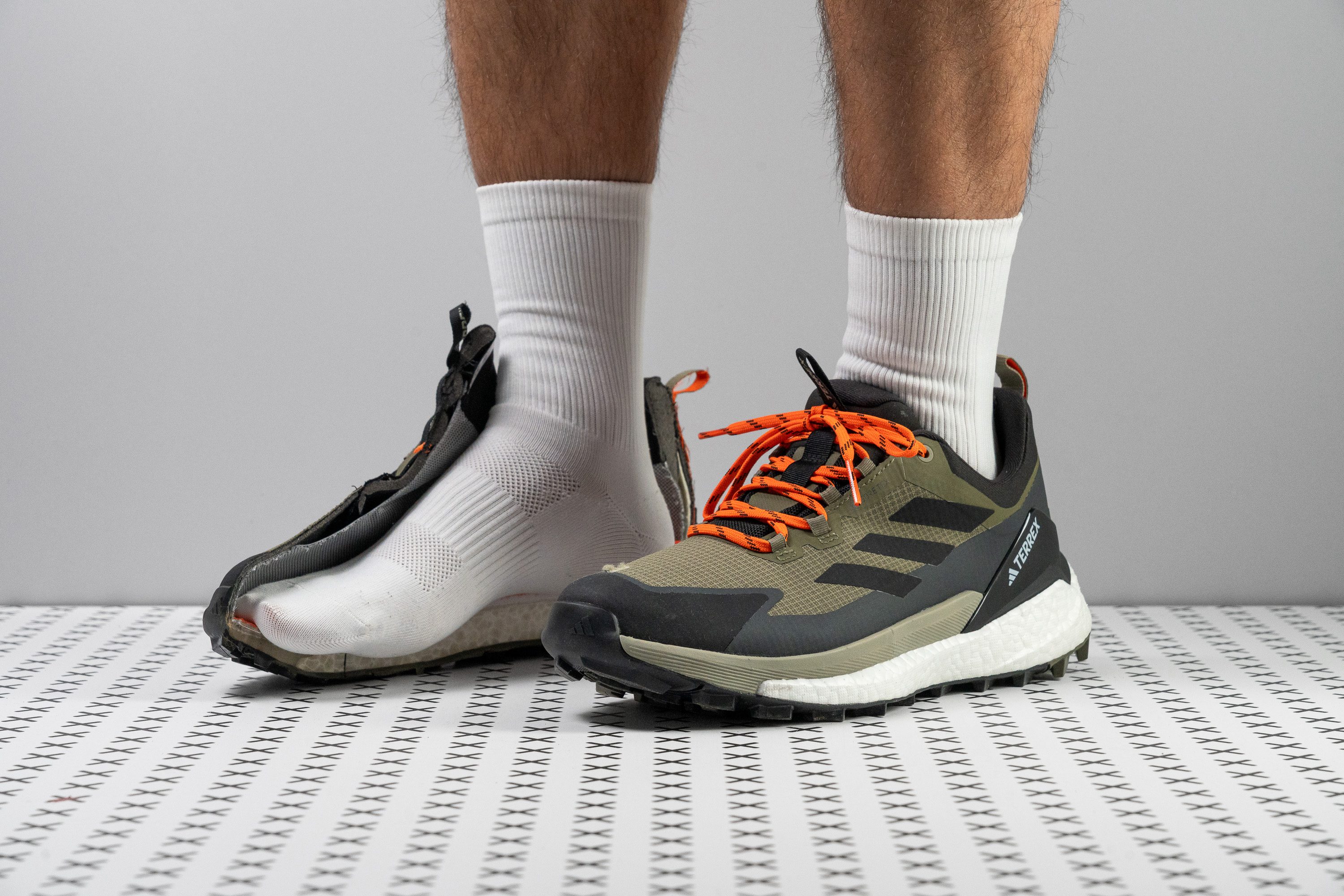



















































What makes it the best?
In a combination of lab tests and getting out on the trail, we found the Adidas Terrex Free Hiker 2.0 Low GTX to be the best shock absorber among Gore-Tex hiking shoes. With layers of foam, we rate its comfort a solid 10/10. It’s also very protective, keeping us surefooted and dry at all times.
This Adidas shoe did not hold back in terms of cushioning. Our caliper reveals a tall 37.2/24.6 mm stack, keeping us elevated from the ground. As if that weren’t enough, we tested the foam's impact protection, and it delivered with a high 126 SA rating, 21.2% above average. There’s no doubt about it, this shoe is all about comfort!
While cushioned shoes can compromise stability, the Terrex Free Hiker 2.0 Low GTX excels in this area. Featuring a massive base—113.9 mm in the forefoot and 93.1 mm in the heel—this design effectively delivers exceptional support, making it nearly impossible to lose balance.
To top it all off, it features the airtight Gore-Tex membrane. Backing it up with figures, its 1/5 breathability score cements its effectiveness as a waterproof shoe. However, be careful that the water level does not go beyond the ankle, or else it won’t dry out.
Pros
- Well-cushioned and responsive
- A ton of impact protection
- Rockered sole makes the ride smoother
- Barely gets firmer in low temperatures
- Excellent support and side-to-side stability
- Top-notch waterproofing
- Highly durable (especially the outsole)
- Ideal grip for technical terrain
- Sustainable materials (20%)
Cons
- Much heavier than average
- TPU heel clips may cause rubbing
Best Gore-Tex hiking shoes for backpacking
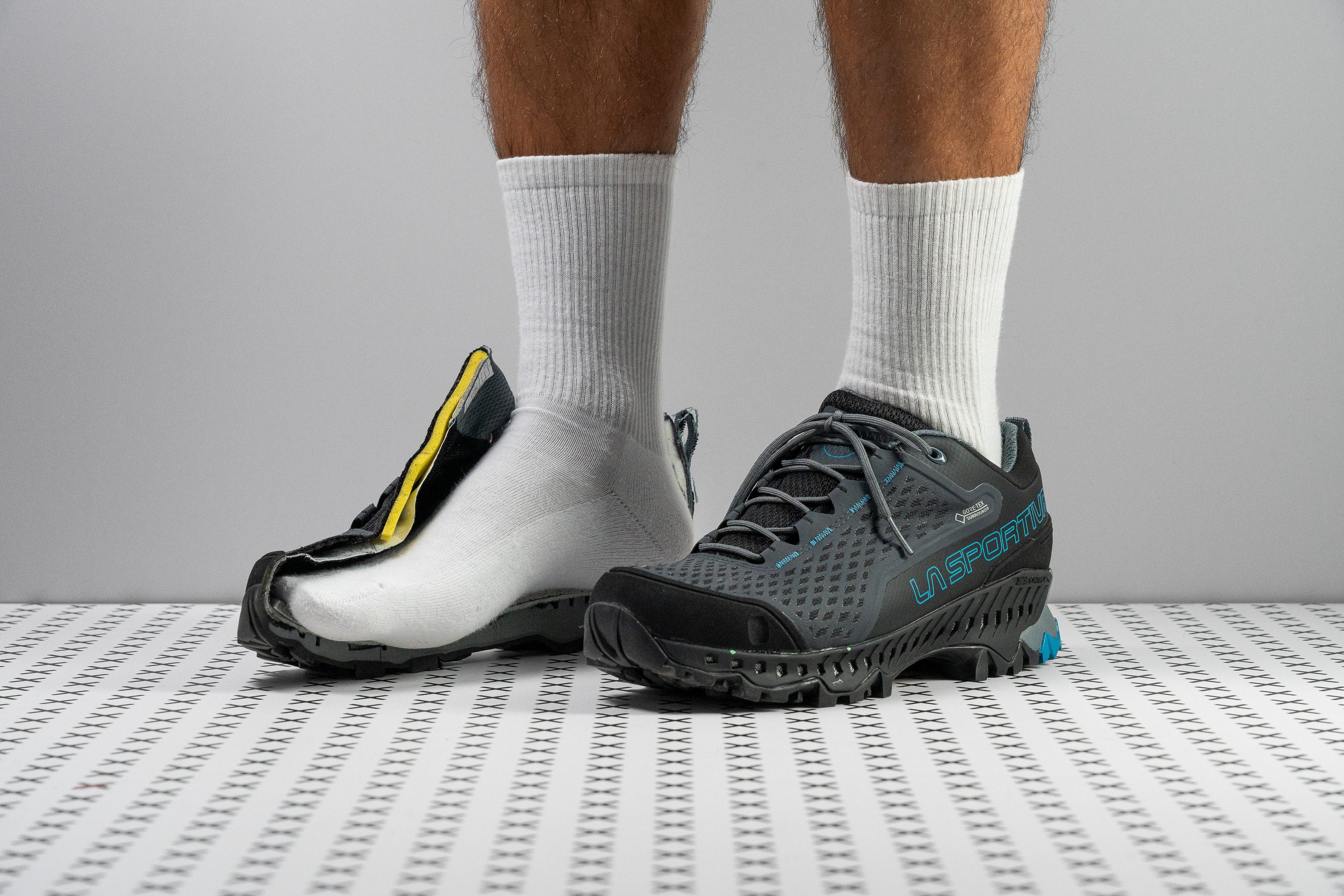





















































What makes it the best?
The La Sportiva Spire GTX is a hiking shoe on steroids, delivering the support and protection of boots without the bulky feeling. With its watertight nature and stable ride, it stands out as the best backpacking Gore-Tex hiking shoe in our lab. We could stay long hours on foot regardless of terrain conditions.
Our feet were well-cushioned with 39.1 mm of heel foam muting out any sharp rocks or debris — that's 7.2 mm above average! The Spire GTX features a steep 16.0 mm heel drop, making it particularly suited for carrying heavy loads due to its ergonomic position.
The shoe’s boot-level stability is mainly attributed to its STB control system, which includes sturdy sidewalls that guide our feet in place. Additionally, the firm 32.6 HA foam underfoot prevents any form of collapse.
Even as we passed through streams or encountered rain, we remained safely dry and warm thanks to the synthetic overlays and Gore-Tex membrane in the upper. Its 1/5 breathability score in our smoke test proves its waterproof nature. Thankfully, it never felt suffocating as it’s designed with some ventilation.
However, this supportive shoe comes at a premium: $209, which is 63.3% more than the average hiking shoe. Those on a budget can check cheaper alternatives.
Pros
- Feels like a backpacking boot with low collar
- Unparalleled stability and support
- Superb waterproofness with some breathabilty
- Mutes out rocks and debris like no other
- Excellent grip and braking
- Sturdy and durable construction
- Greater range of sizes allows to fine tune the fit
Cons
- Can feel tippy on rocky and hilly terrain
- Frail inner lining
- Gets even firmer in cold
Best Gore-Tex hiking shoes with a wide toebox
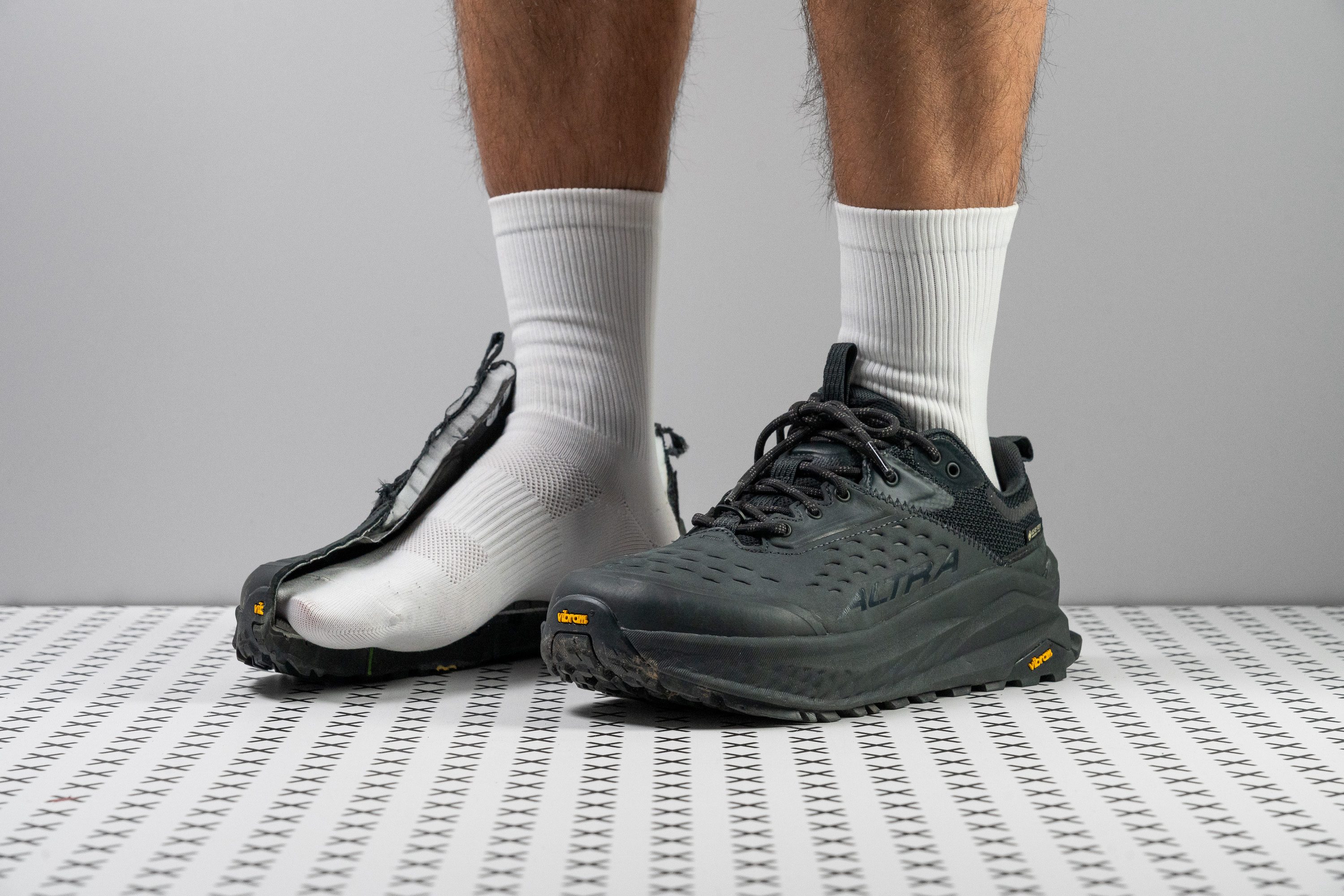
















































What makes it the best?
The Altra Olympus 6 Hike Low GTX ensures comfort and protection reign supreme in our wear tests. Lab tests reveal an extra-wide fit and deep cushioning, making the shoe feel good even during long hours on foot. Meanwhile, its waterproof upper serves as our shield against wet and cold conditions. Overall, it’s our top Gore-Tex hiking shoe with a wide toebox.
We created a gel mold replica to precisely measure the shoe’s interiors, and the widest part came in at 99.9 mm, the widest we’ve ever recorded. Indeed, this Altra has the roomiest foot-shaped fit since the average is only 94.1 mm. The extra space felt kind to our feet even with thick socks on.
Besides the Gore-Tex membrane, the nubuck leather upper shields our feet from puddles and harsh winter winds. In our smoke test, not a single wisp of air could escape, so we gave it the lowest 1/5 breathability score, a reassuring result for watertight shoes.
Even with repetitive impact, our muscles felt well-protected, especially with the thick 29.5 mm forefoot cushioning. The heel stack is a more moderate 31.0 mm, but offers comfort through its high shock absorption (118 SA).
The resulting drop is a low 1.5 mm, which feels flat in actuality. Therefore, we cannot recommend this pair to those with Achilles or ankle pain since the shoe’s set-up may aggravate these conditions.
Pros
- Excellent shock absorption
- Comfortably soft cushioning
- Ultra padded and cozy step-in feel
- Exceptionally wide fit and footshaped toebox
- Extra wide and stable platform
- Highly durable leather and outsole
- Excellent grip on smooth and wet rocks
- Solid waterproofing
Cons
- Not a true zero-drop (1.5 mm)
- Midsole gets notably firmer in cold
- Frail inner lining
Gore-Tex hiking shoes with the best stability














































What makes it the best?
Swift R3 GTX gets the "best stability" medal because, in the world of Gore-Tex hiking shoes, we don't want just superb waterproofing but also a super stable platform that allows us to hike over wet and slippery terrain with no ankle twists, slips and falls. And the Swift R3 GTS nails it!
There are numerous elements contributing to the overall stability of this shoe and we thank our lab tests for documenting all of them. The most important one, for sure, is the torsional rigidity test that showed us why this shoe feels as stable as a hiking boot. Because we weren't able to twist the shoe, we rated it with 5 out of 5, 5 being the stiffest.
Not just that, but we also loved the stiff heel counter - it scored 4 out of 5 on our stiffness test and no wonder: we were able to feel it locking our heels. Boot-like stability means safe and happy ankles and that's what we experienced, no matter how slippery the terrain got!
All the stiffness might sound scary but the shoe is actually quite flexible, 7% more than the average! We loved this because it let us enjoy the outdoors in more natural strides.
When it comes to the grip, in the lab, our durometer showed 85.9 HC when we checked the softness of the rubber. It is just around the average of 86.1 HC. However, when combined with 4.4 mm lugs that shine, especially on downhills, we were blown away by the traction. Talk about feeling secure in wet weather!
Gore-Tex membrane rocks. Under the microscope, it's as tight as it gets, no wonder - but it also means no air can escape. We pumped smoke in the shoe and watched how it barely let anything out, mostly below the laces and not through the toebox. We don't recommend this hiking shoe for hot summer days.
Pros
- Boot-like stability
- Highly durable and protective
- Lightweight for what it offers
- Excellent waterproofing
- Breathable for a GTX shoe
- Responsive ride
- Very secure foothold
- Great grip and deep lugs for mixed terrain
Cons
- Stuffy for summer
- Can be too stiff (even stiffer in cold)
- Break-in needed
Best lightweight Gore-Tex hiking shoes
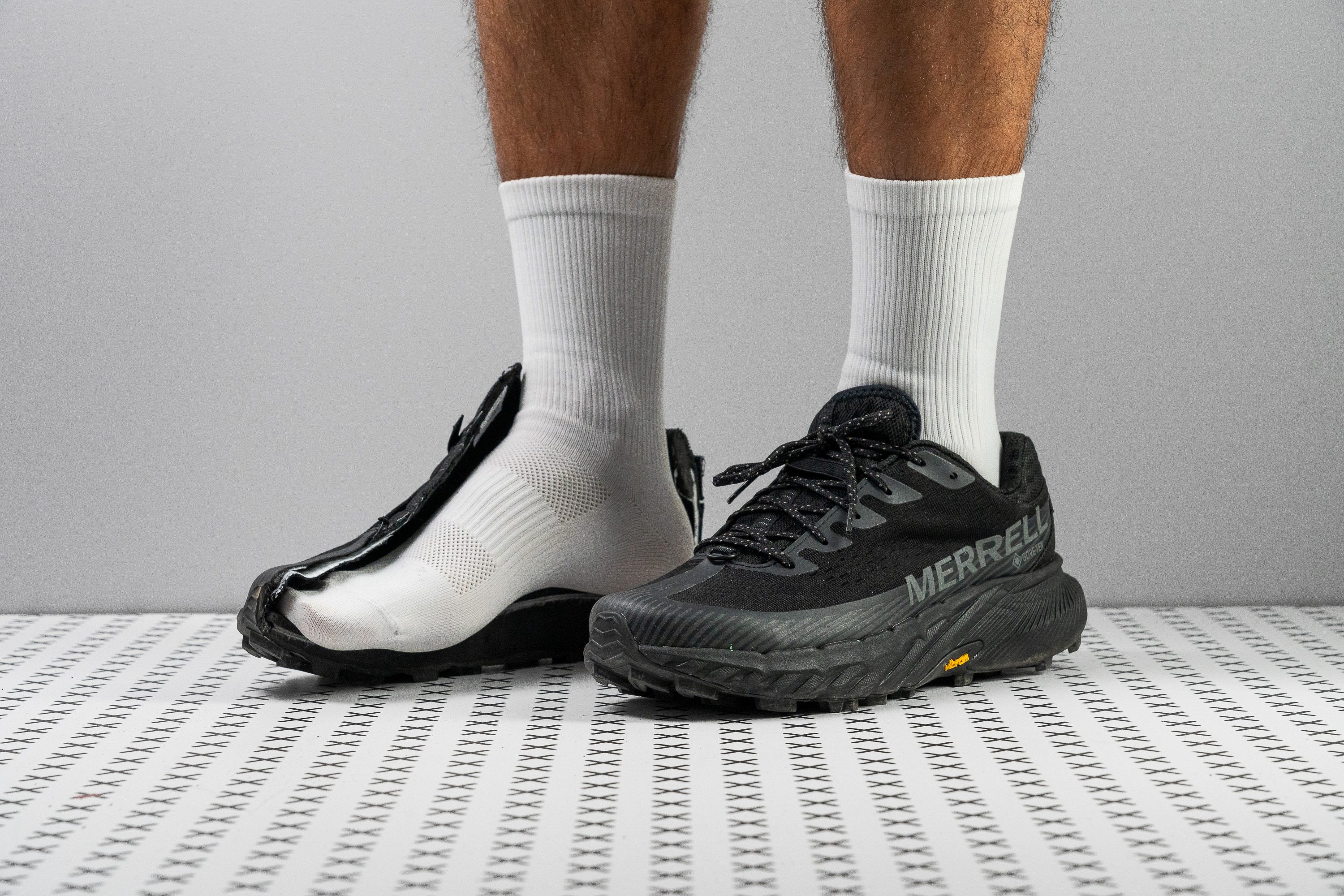













































What makes it the best?
In our treks with the Merrell Agility Peak 5 GTX, we almost wanted to break into a run because of its unmatched lightness and forward-driven midsole. Lab results verify that it features a rockered midsole, wrapped in Gore-Tex lining to keep us safe and dry. Among Gore-Tex hiking shoes, AP5 GTX stands out for its lightweight build.
The scales showed what our feet already knew: AP5 GTX feels like a trail shoe with its low 10.4 oz (296g) figure. Compared to the average hiking shoe, it’s 22.1% lighter, which makes a world of difference when walking long hours outdoors.
Its effortless sensation is magnified through its pronounced rocker, bringing us from our heels to our toes seamlessly. Its flexibility adds to its easygoing nature, emerging 5.9% more bendable than average.
We dealt with rain and shallow streams in our hikes, and not a single drop of water entered the shoes. The upper features Gore-Tex lining and effectively seals the shoe shut from the outside world. Neither light nor smoke could pass through in our lab tests, resulting in the lowest 1/5 breathability rating.
Sadly, the shoe is invisible in the dark. We highly recommend wearing reflective elements, either through clothing or accessories, when using this pair in the dark.
Pros
- True waterproof protection
- Grippy, trail-ready Vibram outsole
- Perfect for cold, wet climates
- Can handle some challenging conditions
- Stable yet cushioned heel
- Improved for hiking and walking
- Well-designed outsole lugs
- Great build quality
- Keeps feet warm
- Rock plate
Cons
- Narrow toebox
- Heel padding durability concerns
- No reflective elements
- Drop differs too much from stated
How to recognize Gore-Tex hiking shoes
It’s as simple as looking for the Gore-Tex logo on the shoes or looking for Gore-Tex or GTX in the shoe name.
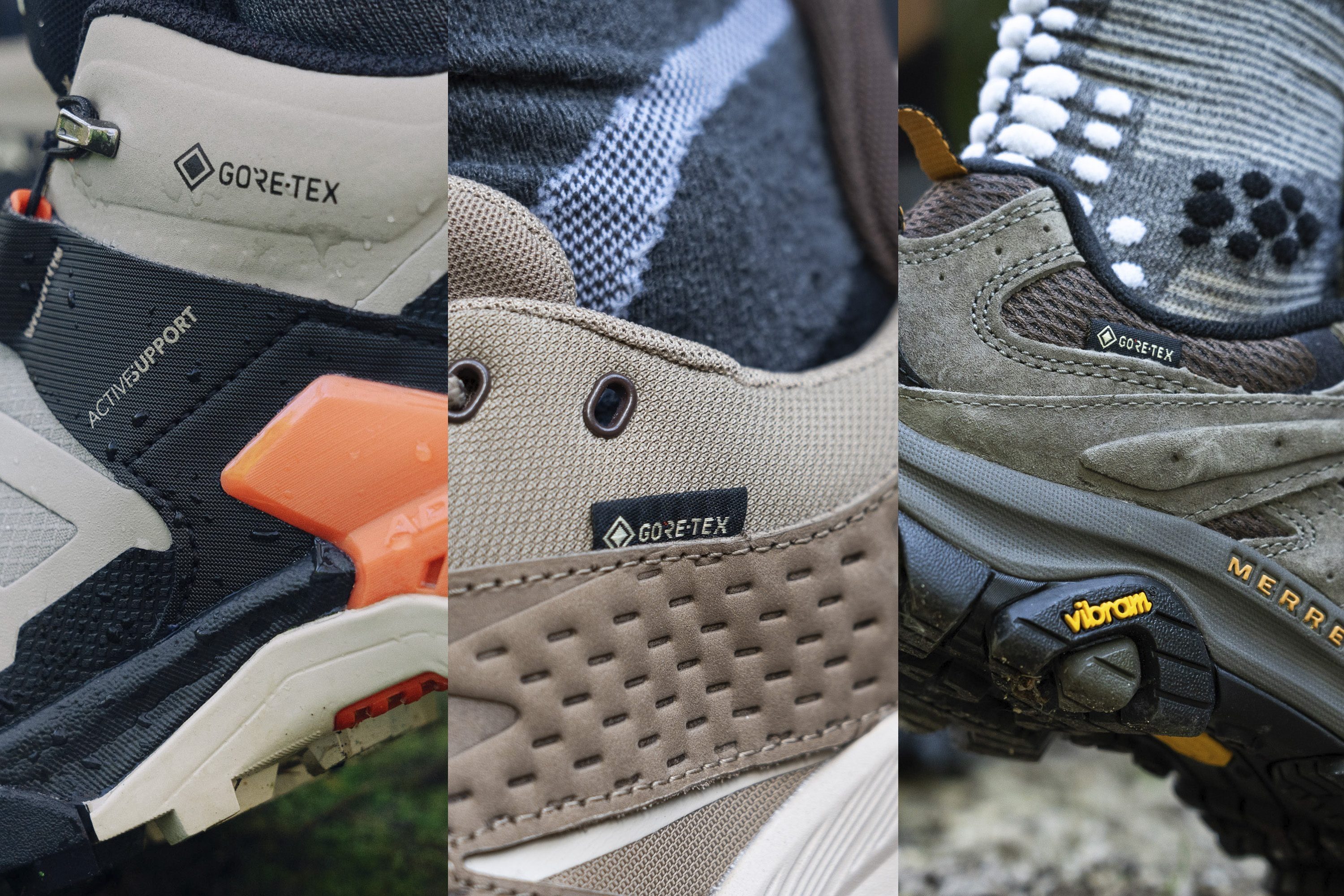
Once you’ve found that, welcome to the world of waterproof GTX hiking shoes. The Gore-Tex membrane is basically a guarantee for watertightness.
When you SHOULD get GTX hiking shoes
To start with pros, GTX hiking shoes are, obviously, waterproof and windproof.
These shoes are ideal for hiking in wet weather or, to be more specific:
- When you anticipate rainfall, mud, snow, groundwater
- When you’re hiking through high wet grass
- When you’re crossing shallow creeks and streams.
However, rain can still get inside your shoes:
- By sliding down your trousers or legs
- When you enter a body of water that is deeper than the height of your eyelets or heel collar.

We recommend avoiding this to a great degree by using knee-high gaiters. They also come in GTX versions and do a magnificent job of keeping your shoes water-free because all the water slides down the gaiters and onto the shoes and/or ground.
When you should NOT get GTX hiking shoes
Even though the brand says the Gore-Tex membrane is breathable, our lab tests and wear tests have shown the opposite. We don’t just hike in the shoes we test but we also pump the smoke into them and watch where the smoke comes out and at which pace. This allows us to rate the breathability on a 1-5 scale, where 5 is the most breathable.
In this video, it is clear how the GTX shoe does not breathe compared to the non-GTX shoe on the right
This is the biggest downside of a Gore-Tex shoe. If your feet sweat a lot or if the water gets inside, it’s almost impossible for your socks and shoes to dry out on their on as you hike further. This, unfortunately, can lead to discomfort and blisters, to start with.
See how GTX hiking shoes performed on our breathability test:
This is why we don’t recommend GTX hiking shoes if there’s no point in using them: if there’s no rain, snow, or ground water. We also don’t recommend using them in hot weather due to their disappointing breathability. If there’s a small chance of getting hit by the weather and it’s nothing extreme, consider getting water-resistant or water-repellent hiking shoes.
Don’t slip in GTX hiking shoes!
It’s all about figuring out what kind of outsole and lugs you need. Hiking in wet terrain usually means 2 types of terrain and, depending on that, 2 types of lugs.
- For hard flat surfaces, usually rocky ones, we recommend around the average ~4 mm sticky lugs.
- For loose wet ground: slush, mud, or snow, we recommend deeper lugs (4 mm and above).
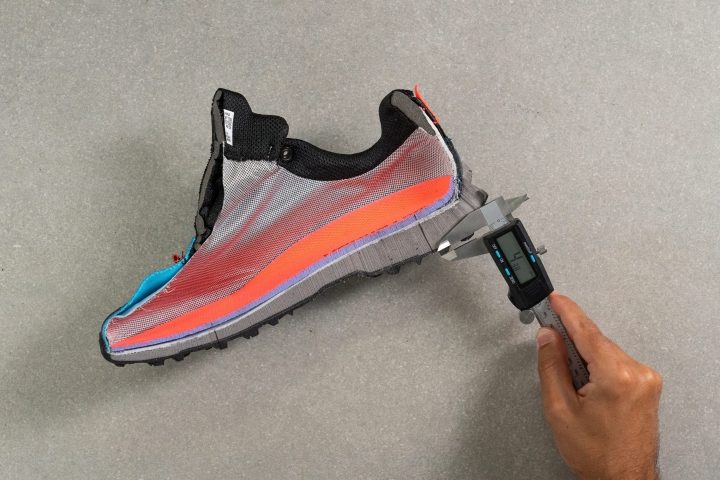
In our lab, we use a caliper to measure the depth of the lugs. But, we don’t stop there. We also check the softness of the outsole because softer rubbers usually stick better to the ground. The HC durometer shows the hardness of the rubber: the bigger the number, the harder the outsole.
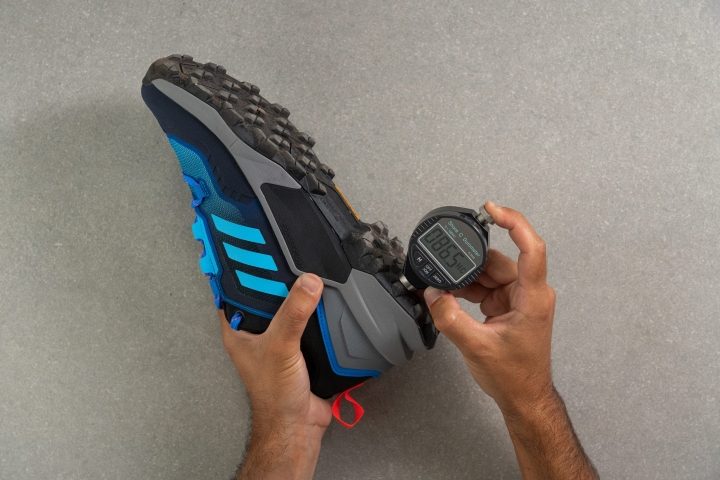
There are, however, 2 more things to keep in mind when it comes to grip in wet terrain:
- If you use hiking shoes with deeper lugs and softer rubber, which are meant for soft ground, on hard surfaces, they will wear out sooner. Good thing is, in our reviews we always measure the hardness of the rubber and you can always compare it to the average or hardness in other shoes.
- Lugs that are widely spaced are better at shedding mud.
This image clearly shows the difference between a hybrid outsole (left) that's great for road-to-trail with its shallow numerous lugs, soft-ground outsole (middle) with deep lugs that is great for loose terrain, and mud outsole (right) with very deep lugs that are distanced from each other

Gore-Tex under the microscope
This is a part of our breathability testing. We examine every upper under the microscope to understand all the nuances related to breathability. See how tightly woven the fibers are on Gore-Tex uppers in hiking shoes:
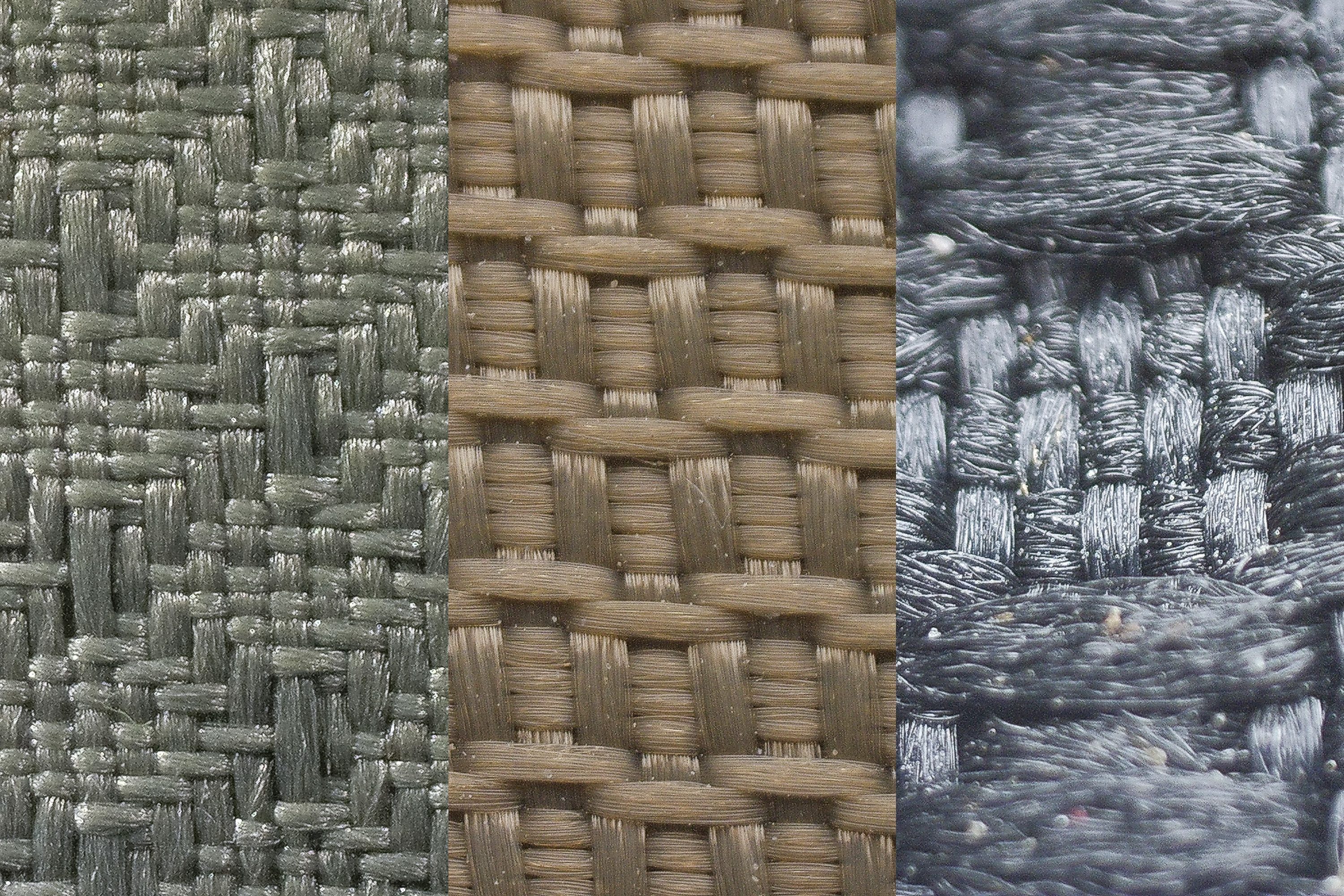
It is very clear why they are not breathable. For comparison, look at the 'regular' uppers under the microscope:
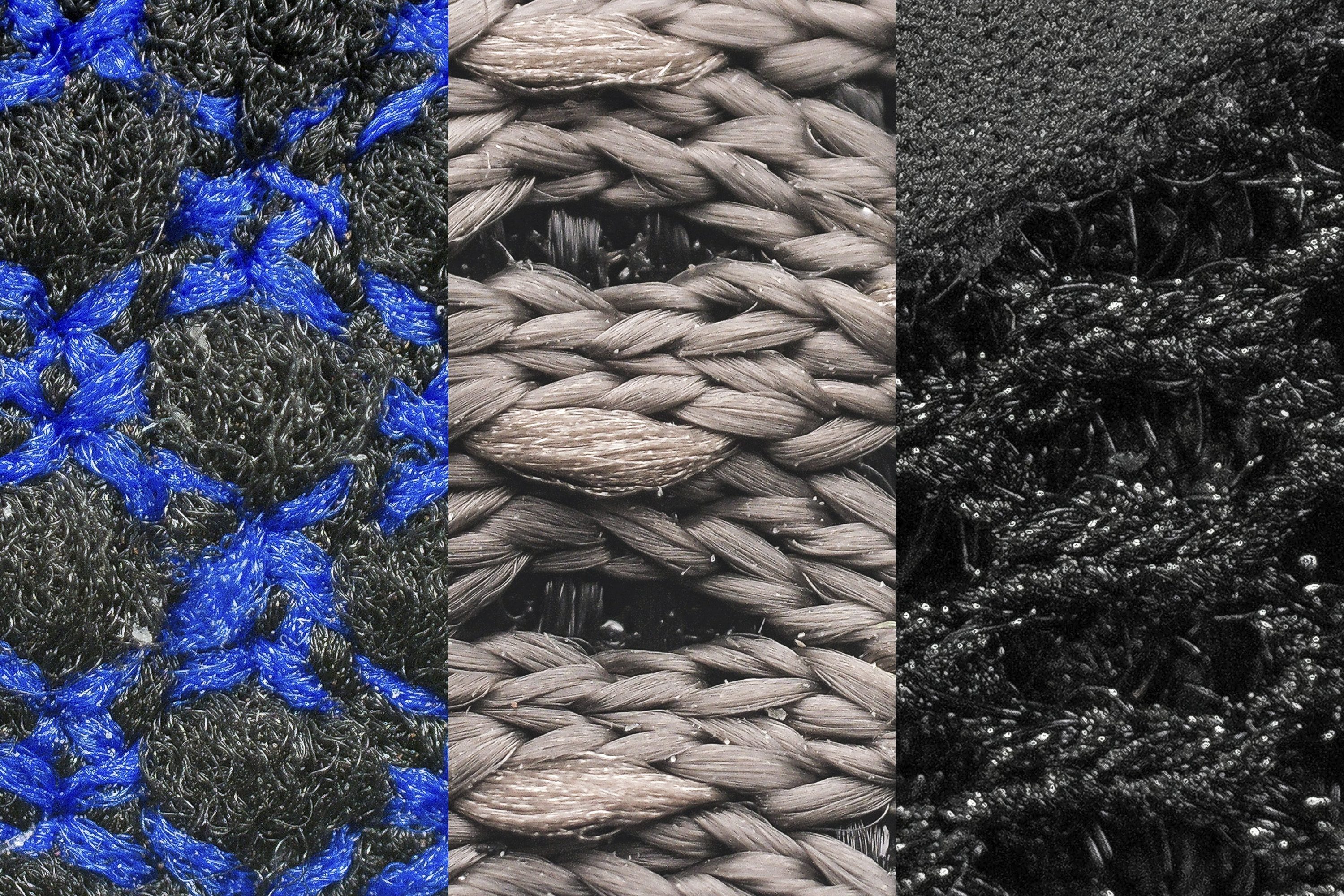
The manufacturer clearly says that every inch of the GTX membrane has 9 billion pores and that every pore is 20,000 times smaller than a water droplet. Because of this, according to them, it’s possible for the material to be waterproof and breathable at the same time.
We don’t agree on the breathable part and our tests have proven it. As we can see above, the GTX uppers look pretty different than the other, nonwaterproof uppers. Hiking shoe uppers are usually made of different materials, not just one. GTX membrane is simply implemented, it is not standalone.
GTX hiking shoes are heavier and more expensive
Usually, they weigh a bit more. In the lab, we always measure the weight of the shoe on our scale.
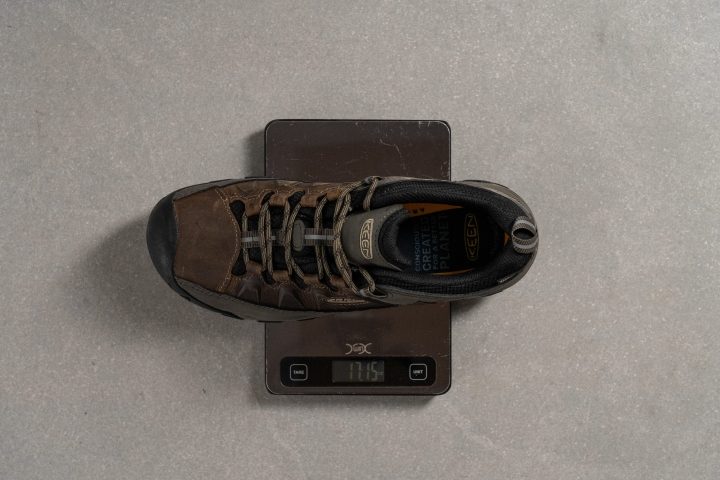
Slippery terrain asks for extra stability
It could be very dangerous to cover slippery terrain in hiking shoes that are not stable. Luckily, we test for stability out there on the hikes and in our lab.
In the lab, we use a caliper to measure the width of the midsole (base), at the forefoot and at the heel. The wider the base, the more stable the shoe.
We also squeeze the heel counter as its stiffness can help with the overall supportive and stable feel. We rate it on a scale of 1 to 5, where 5 is the stiffest.
When it comes to lateral stability, we test it outside the lab and always cover it in every shoe review as a separate section.
Perfect fit in GTX hiking shoes
The rules that apply here apply to all hiking shoes. We wrote a very detailed guide on how to find the best pair of hiking shoes for you. When it comes to nailing the perfect fit, we advise sticking to these steps:
- Wait for the afternoon to go shoe shopping. By then, your feet will most likely swell a bit, similar to how they swell on a hike.
- Bring your regular hiking socks with you. Use them when trying the GTX hiking shoes on.
- Once you’ve put the shoe on, lace it up and try to sense all the pressure points. If the shoe is cramping your toes, the toebox is too narrow. If there’s a poking sensation anywhere, try another shoe. Aim for the perfect fit: not too loose and definitely not too tight!
- If you’re using orthotics/insoles, try the shoes with them, then and there.
- Walk up and down the ramp. Most outdoor shops have it, usually covered with grass, pebbles, larger rocks, etc. Your feet should not slide within the shoe (to the sides or forward-backward), not when you’re walking uphill or downhill.
- Many GTX hiking shoes ask for some break-in period. Make sure to give them that!
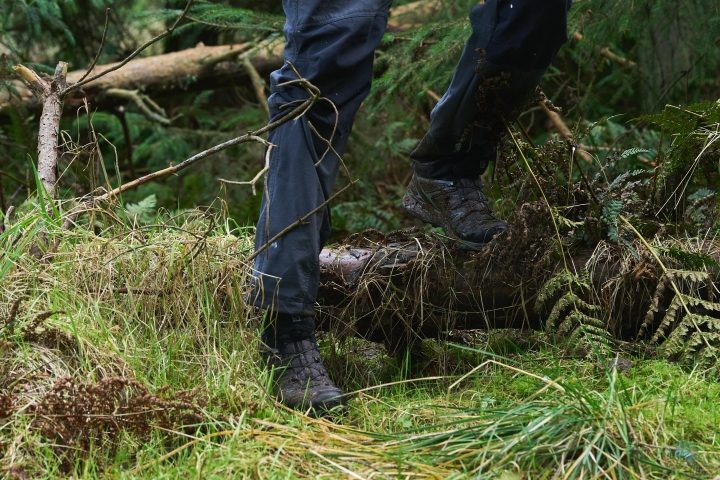
Toebox volume in GTX hiking shoes: lab data
If you have a wider forefoot, we recommend GTX hiking shoes with a wide toebox. Fortunately, we cover this in the lab as well by measuring the width of the shoe in 2 places: where it's the widest and at the big toe. Knowing both measurements helps hikers understand which toebox is better for them: a pointy one or a more foot-shaped one.
Pouring a gel into the GTX hiking boot and freezing it
This gel mold is perfect for taking the measurements because it fills the shoe entirely and we're able to get the inner width measurements, not the outside ones. Taking measurements on the outside would not take into account thick overlays, toe bumpers, etc., and those could often be misleading.
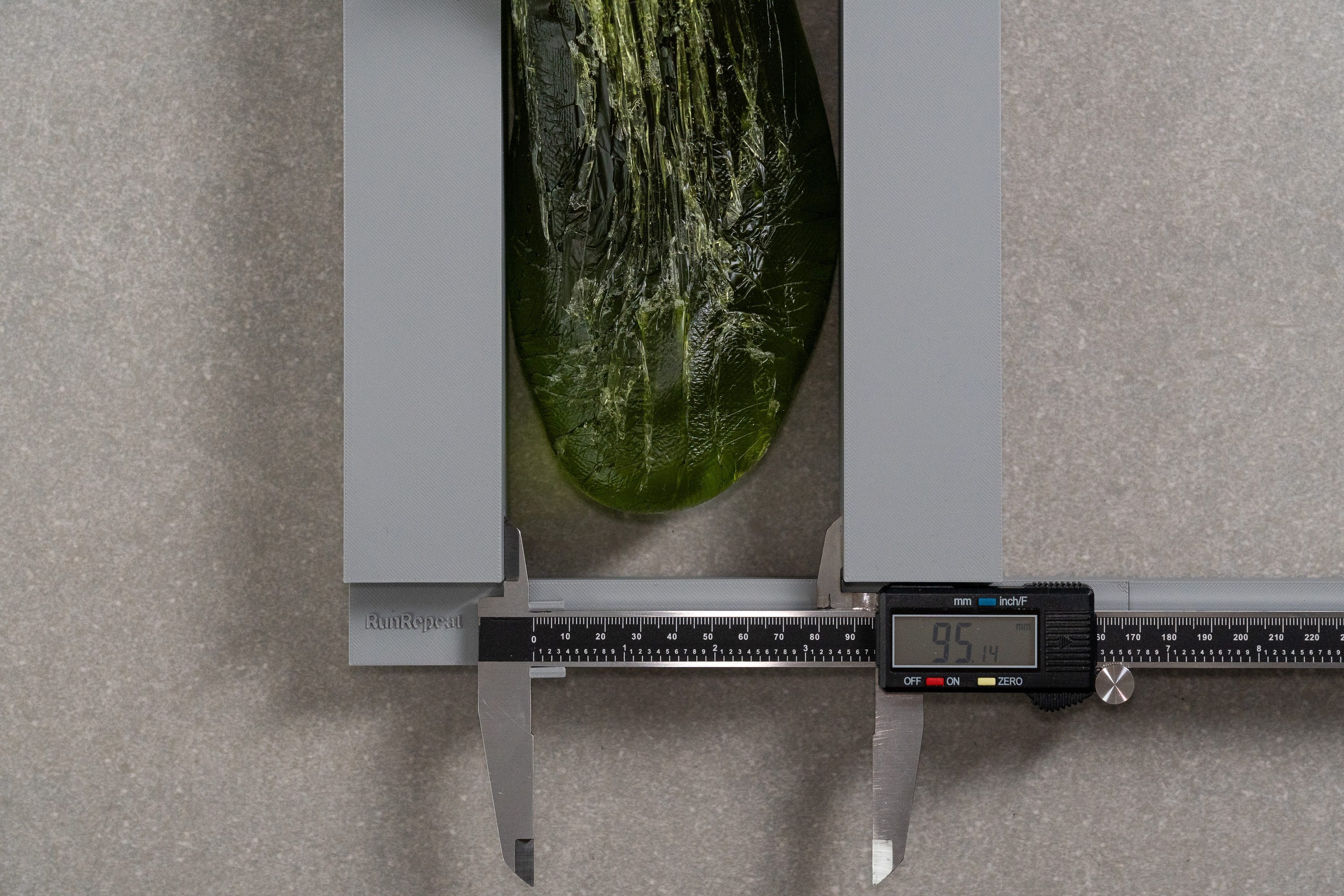
Keep in mind that we always test Men's US 9, medium width shoes.
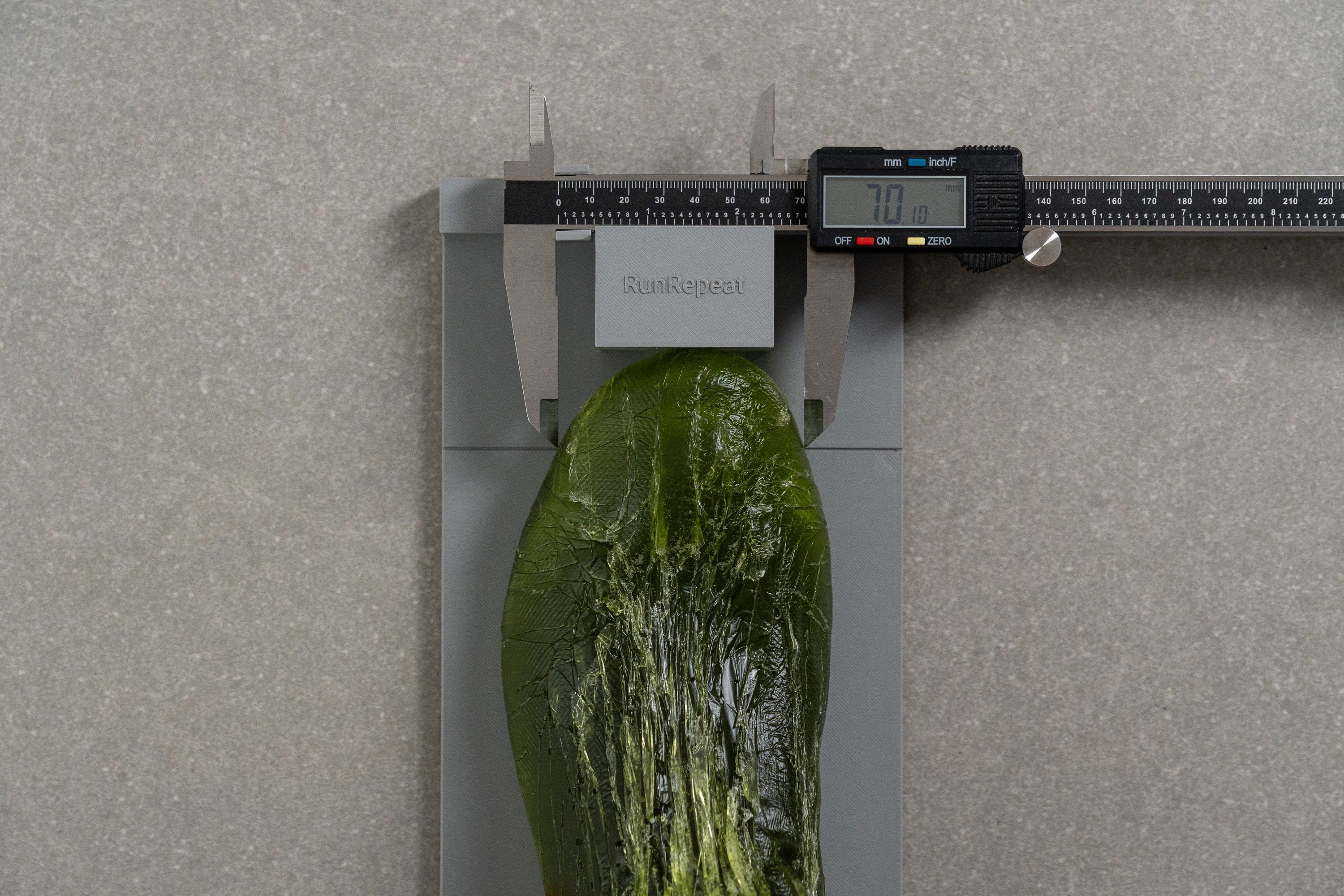
Keep in mind, though, that loose fit is a bad idea, especially on slippery terrain. Make sure the shoe fits great. Best to aim for the perfect lockdown: no sliding!
You may also need more height in the toebox. If that's the case, we've got you covered as we measure that as well in our lab.

Here's a selection of Gore-Tex hiking shoes with the highest toeboxes for your convenience:
Is Gore-Tex the only waterproof membrane?
No. It is the most common one, but not the only one.
- Columbia Sportswear uses its patented OutDry and Omni-tech technology to waterproof footwear
- Keen uses KEEN.DRY waterproof membrane technology
- Merrell has its own waterproof membrane
- Danner uses DannerDry on their leather to ensure a higher level of watertightness, etc.
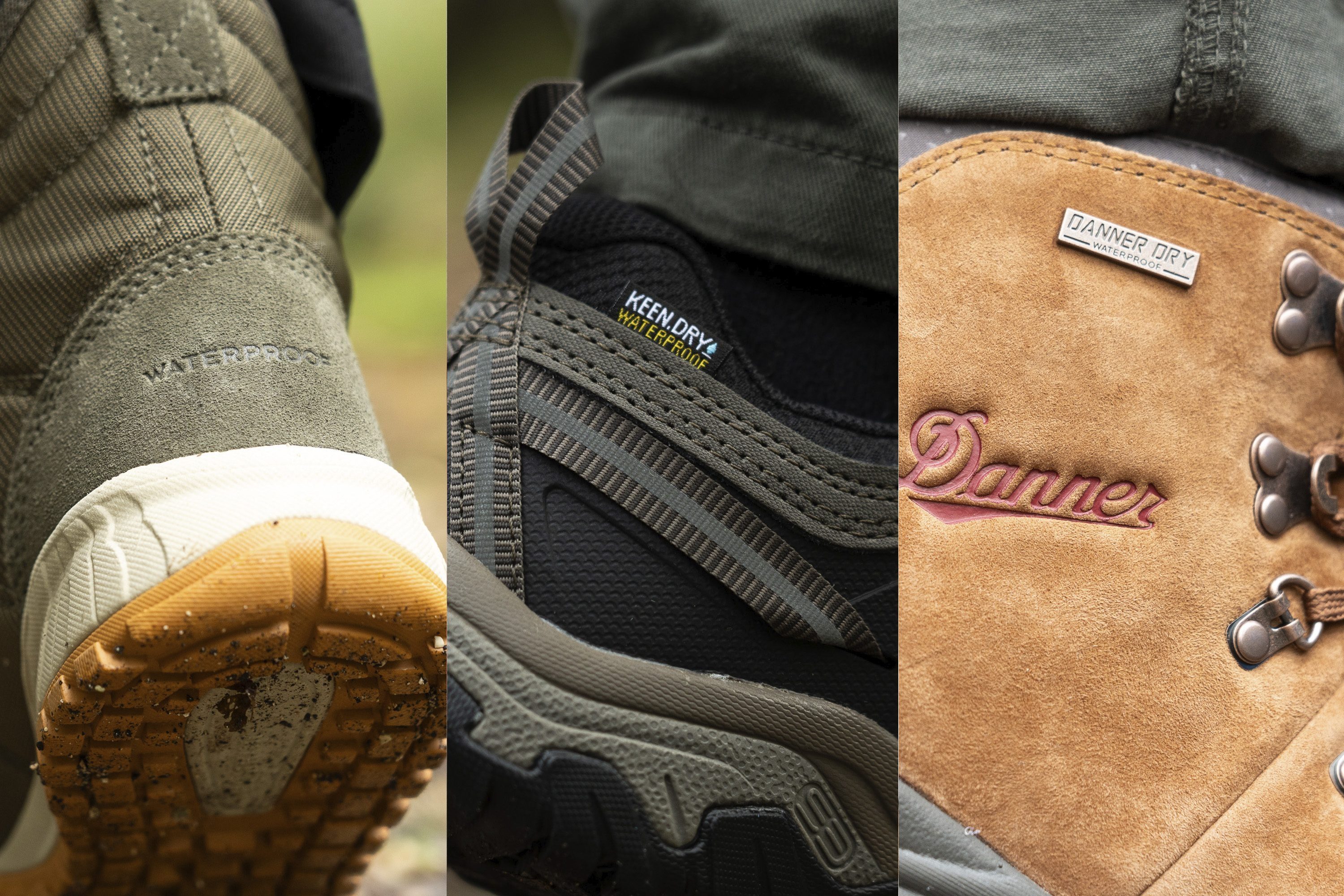
A brief history of Gore-tex
Starting in 1958, Bill and Genevieve Gore were onto something special. They were curious about a revolutionary and new polymer called polytetrafluoroethylene (PTFE). PTFE is a synthetic polymer called a fluoropolymer. It’s well known for being hydrophobic, having a high melting point, and resistant to abrasion via a high tensile strength.
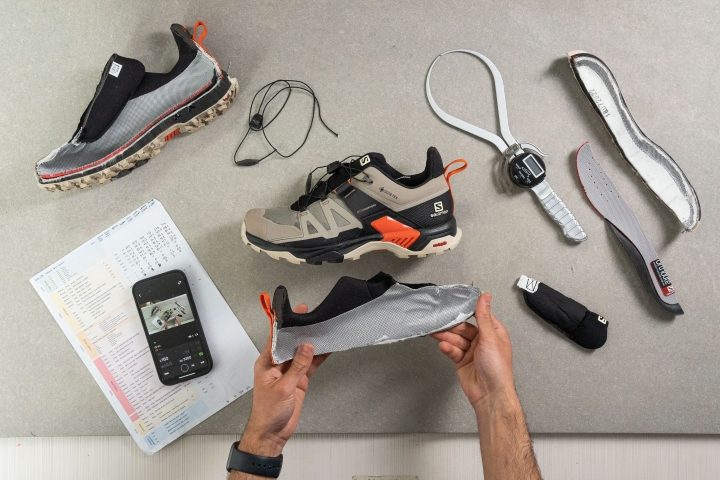
It was first patented by Kinetic Chemicals in 1941 and trademarked as Teflon. One of its first uses was as a seal coating in uranium enrichment for the Manhattan Project. Later, Teflon was used for cookware.
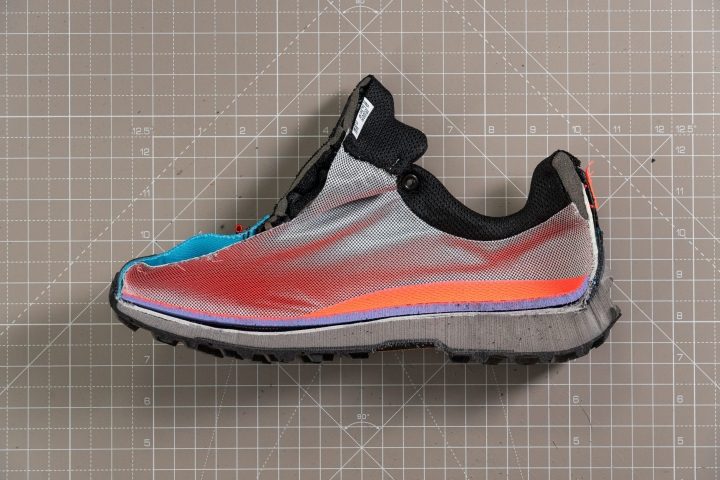
A decade later, in 1969, the Gores’ son, Bob Gore, discovered what eventually became known as expanded polytetrafluoroethylene, or ePTFE for short. To create ePTFE, Gore stretched the PTFE under certain conditions. What he created was a heat-resistant, hydrophobic, and thin fabric.
Bob Gore understood that he was onto something with great potential. In 1970 Gore applied for a series of patents to make Gore-tex fabrics more seriously. And shortly afterward, in 1976, he started marketing their family brand, Gore-tex. At the time, it was the first waterproof and windproof fabric.
Afterward, Gore-tex became the gold standard for waterproof fabrics and was utilized in a variety of applications, the first of which was a rainjacket. Since then, Gore-tex is also commonly used in manufacturing gloves, space suits, and footwear.

